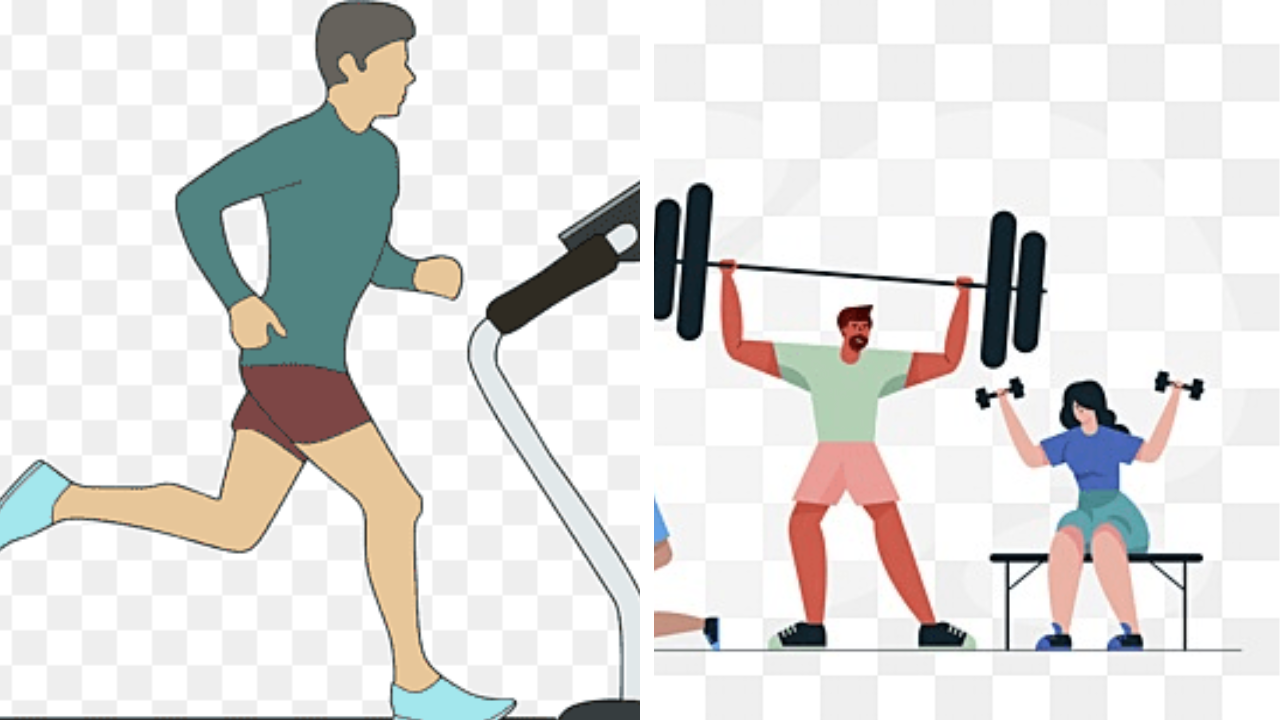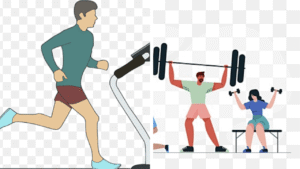Exercise refers to any physical activity that improves or sustains physical fitness and health, typically characterized by being planned, structured, and repetitive. It is distinct from general physical activity in that it is intentional, aimed at enhancing or preserving physical fitness, which can be achieved through activities such as running, dancing, or organized workouts.
Engaging in regular physical activity — ideally on a daily basis — is the most crucial action you can take for your health. In the immediate term, exercise aids in regulating appetite, enhancing mood, and promoting better sleep. Over the long haul, it lowers the likelihood of developing heart disease, stroke, diabetes, dementia, depression, and various types of cancer.
One key question often arises: What is the benefit of physical exercise activities? This inquiry emphasizes the importance of understanding how exercise contributes to overall well-being, particularly in enhancing physical fitness and health.
Why is exercise so important for seniors?
Why is exercise crucial for older individuals? Elevating your heart rate and challenging your muscles positively impacts nearly every system in your body, enhancing both your physical and mental well-being in numerous ways. Engaging in physical activity aids in maintaining a healthy blood pressure, prevents harmful plaque accumulation in your arteries, diminishes inflammation, regulates blood sugar levels, fortifies bones, and helps combat depression. Furthermore, a consistent exercise regimen can enhance your sexual health, improve sleep quality, lower the risk of certain cancers, and is associated with increased longevity.
Many older adults are reluctant to engage in physical activity due to their lack of familiarity with effective and safe exercise types, as well as uncertainty regarding the amount of exercise required. The encouraging news is that any form of movement is preferable to a sedentary lifestyle, so beginning with small steps and gradually progressing to longer workouts is perfectly acceptable. Your objective should be to achieve at least 150 minutes of moderate-intensity activity each week; however, if you are unable to start at that level, aim to gradually reach it (and eventually exceed it). While there are numerous specialized exercise and fitness programs for older adults, it is also important to remain physically active throughout the day by utilizing stairs, engaging in yard work, and playing with your grandchildren.
Regarding exercise and fitness for seniors, most individuals can commence without prior consultation with a physician — although there are exceptions. If you have a significant health condition such as diabetes, hypertension, heart or lung disease, osteoporosis, or a neurological disorder, it is advisable to consult your doctor beforehand. Individuals with mobility challenges, including poor balance or arthritis, should also seek guidance from their healthcare provider.
What are the most effective forms of exercise?
Aerobic exercise is characterized by an elevated heart rate. While most aerobic activities necessitate the movement of your entire body, the primary emphasis is on your heart and lungs (aerobic exercise is frequently referred to as “cardio” due to its challenge to and benefits for the cardiovascular system). Activities such as walking, swimming, dancing, and cycling, when performed at an adequate intensity, increase your breathing rate and elevate your heart’s workload. Aerobic exercises facilitate fat burning, enhance mood, diminish inflammation, and lower blood sugar levels.
Strength training, often known as resistance training, should be conducted two to three times weekly. Exercises like squats, lunges, push-ups, and those performed on resistance machines or with weights or bands contribute to the maintenance and even growth of muscle mass and strength. Additionally, strength training aids in fall prevention, sustains bone density, reduces blood sugar levels, and enhances balance.
Incorporate both isometric and isotonic exercises into your routine. Isometric exercises, such as planks and leg lifts held in position, are executed without movement. They are effective for preserving strength and enhancing stability. Conversely, isotonic exercises involve bearing weight through a range of motion. Examples of isotonic exercises include bicep curls, bench presses, and sit-ups.
How much exercise do I need?
How much exercise you should engage in is contingent upon various factors, including your existing fitness level, your fitness objectives, the types of exercises you intend to undertake, and whether you have deficiencies in areas such as strength, flexibility, or balance.
As a general guideline, it is recommended to engage in 150 minutes of moderate-intensity aerobic activity (or 75 minutes of vigorous exercise) as a weekly minimum. As your fitness improves, you should aim to surpass this amount to achieve maximum benefits. A practical way to distribute the 150 minutes could be to conduct a 30-minute session five times a week, or alternatively, you may divide it into two 15-minute sessions within a single day. Choose a schedule that aligns with your lifestyle.
For strength training, strive to work all major muscle groups two to three times each week, ensuring a 48-hour recovery period between each session. If you opt for total-body workouts, that would equate to two sessions weekly. Conversely, if you prefer to split your workouts to focus on a specific muscle group (for instance, a “leg day”), this will necessitate more frequent sessions. Just ensure that you allow for 48 hours of rest before targeting a major muscle group again.
If you have experienced issues with your balance, such as unsteadiness, dizziness, or vertigo, consult a healthcare provider for advice on balance-specific exercises. Aim to incorporate three half-hour workouts each week, in addition to a 30-minute walk at least twice a week.
It is advisable to stretch after warming up for a few minutes or to perform stretching exercises following your workout. When stretching each muscle group, proceed slowly and steadily, release, and repeat the process.
Benefits of exercise
Consistent physical activity has been demonstrated to increase energy levels and improve mood. Additionally, it may be linked to numerous other health advantages, such as a lower risk of chronic illnesses. Physical activity is characterized as any movement that engages your muscles and necessitates calorie expenditure. Various forms of exercise exist, including swimming, running, and walking, among others. Engaging in regular activity has been proven to offer numerous health benefits, both for the body and mind. It may even contribute to a longer lifespan.
Regular physical activity and exercise can:
- Assist you in achieving and maintaining a healthy weight. In conjunction with a balanced diet, exercise is crucial for sustaining a healthy weight and preventing obesity. If you are at a healthy weight, you can keep it stable by ensuring that the calories consumed are equivalent to the energy expended. To achieve weight loss, it is necessary to expend more calories than are consumed.
- Decrease your likelihood of developing heart diseases. Engaging in exercise fortifies your heart and enhances circulation. The increased blood flow elevates oxygen levels within your body, thereby reducing the risk of heart-related conditions such as coronary artery disease and heart attacks. Regular physical activity can also help lower elevated blood pressure, cholesterol, and triglyceride levels, which are all significant risk factors for heart disease.
- Assist your body in regulating blood glucose (sugar) and insulin levels. Exercise has the potential to decrease blood glucose levels and enhance the efficacy of insulin. This can lower your risk of developing metabolic syndrome and type 2 diabetes. Furthermore, if you are already diagnosed with either condition, regular exercise can aid in its management.
- Aid in managing chronic health conditions. For instance, consistent physical activity may alleviate pain and enhance functionality in adults suffering from arthritis. It can also facilitate daily living activities for individuals with disabilities, promoting greater independence.
- Support your efforts to quit smoking. Engaging in exercise may ease the process of quitting smoking by diminishing cravings and withdrawal symptoms. Additionally, it can help mitigate any weight gain that may occur upon cessation of smoking.
- Enhance your mental health and mood. During physical activity, your body releases chemicals that can elevate your mood and induce relaxation. This can assist in coping with stress, managing anxiety, and lowering the risk of depression.
- Help maintain cognitive functions, learning, and judgment skills as you age. Exercise encourages your body to produce proteins and other chemicals that enhance the structure and functionality of your brain.
- Enhance the strength of your bones and muscles. Engaging in regular physical activity can assist children and adolescents in developing robust bones. As one ages, it can also mitigate the decline in bone density associated with aging. Participating in muscle-strengthening exercises can aid in increasing or preserving muscle mass and strength. For senior individuals, this may translate to maintaining independence, such as the ability to rise from a chair or bed without assistance.
- Lower your risk of various cancers, including those of the colon, breast, uterus, bladder, esophagus, kidney, stomach, and lung. There are several mechanisms through which physical activity may diminish the likelihood of these cancers. For instance, it can bolster your immune system and decrease inflammation within your body. Additionally, it aids in preventing obesity, a known risk factor for numerous cancers.
- Minimize your risk of falls. For elderly individuals, engaging in balance and muscle-strengthening exercises can significantly lower the likelihood of falling.
- Enhance your sleep quality. Physical activity can facilitate quicker sleep onset and prolong sleep duration.
- Increase your energy levels. Exercise improves the functioning of your heart and lungs, which can result in a heightened sense of energy throughout the day.
- Enhance your sexual health. Regular physical activity may reduce the risk of erectile dysfunction (ED) in men. For those who are already experiencing ED, exercise may contribute to improved sexual function. In women, physical activity may heighten sexual arousal.
- Boost your chances of longevity. Research indicates that engaging in physical activity can lower the risk of premature death from leading causes such as heart disease and certain cancers.
Most Effective Exercises
There is no enigma surrounding exercise: The results you achieve are directly proportional to the effort you invest. However, it is not necessary to engage in lengthy workouts every day. What is essential is to exercise intelligently.
Walking
Any exercise regimen should incorporate cardiovascular activities, which enhance heart function and facilitate calorie burning. Walking is an exercise that most individuals can perform anywhere and at any time, requiring only a decent pair of shoes.
It is not solely for novices: even those who are highly fit can achieve a substantial workout through walking.
“Engaging in a brisk walk can expend up to 500 calories per hour,” states Robert Gotlin, DO, director of orthopaedic and sports rehabilitation at Beth Israel Medical Center in New York. Given that a deficit of 3,500 calories is necessary to lose one pound, one could anticipate shedding a pound for every seven hours of walking, assuming no other activities are undertaken.
However, it is advisable not to transition from a sedentary lifestyle to walking for an hour each day immediately. Beginners should commence with walking for five to ten minutes at a time, progressively increasing to a minimum of 30 minutes per session, according to Richard Cotton, a representative for the American Council on Exercise.
“Avoid increasing your walking duration by more than 5 minutes at a time,” he advises. Additionally, as your fitness level improves, it is preferable to extend the duration of your walks before increasing your pace or elevating the incline on your treadmill.
Interval Training
Whether you are new to exercise or have been active for many years, incorporating interval training into your cardiovascular routine can enhance your fitness level and may assist in weight loss.
“Altering your pace during the workout engages the aerobic system to adapt,” states Cotton. “The greater the power of the aerobic system, the higher your capacity to burn calories.”
To implement this, increase the intensity or speed for one to two minutes, then reduce it for a duration of 2 to 10 minutes (depending on the length of your overall workout and your recovery needs). Repeat this pattern throughout your session. Consult a trainer to determine what an appropriate interval is for you.
Squats
Strength training is equally important. “The more muscular fitness you possess,” Cotton remarks, “the higher your ability to burn calories.”
The professionals consulted for this article generally preferred strength-training exercises that engage multiple muscle groups. Squats, which target the quadriceps, hamstrings, and glutes, serve as an excellent illustration. “They provide the best value because they engage the most muscle groups simultaneously,” explains trainer David Petersen from Oldsmar, FL.
Maintaining proper form is crucial. “The functionality of an exercise is determined by how you execute it,” Petersen notes. “If your technique is poor, it ceases to be functional.”
For squats, position your feet shoulder-width apart and keep your back straight. Bend your knees and lower your hips. “Ensure that your knee stays aligned over your ankle as much as possible,” advises Cotton. “Imagine how you would sit down in a chair, but without the chair present,” suggests Gotlin.
Practicing with an actual chair can be beneficial, according to physical therapist Adam Rufa from Cicero, NY. “Begin by focusing on properly getting in and out of a real chair,” he recommends. Once you have mastered that, try merely tapping the chair with your bottom before returning to a standing position. Then, replicate the same movement without the chair.
Lunges
Like squats, lunges engage all the primary muscles of the lower body: gluteals, quadriceps, and hamstrings. A lunge is an excellent exercise as it simulates walking, albeit in a more pronounced manner, according to Petersen. Lunges are somewhat more advanced than squats, contributing to improved balance as well, as noted by Cotton.
Here is the correct way to perform them: Take a substantial step forward while maintaining a neutral spine position. Bend your front knee to about 90 degrees, ensuring that your weight is on the back toes and lowering the knee of your back leg toward the ground. Petersen advises visualizing yourself sitting on your back foot. “The trailing leg is the one you need to sit down on,” he explains. To enhance the functionality of a lunge, Rufa suggests attempting to step not only forward but also backward and to each side.
“Life is not linear; it is multiplanar,” Rufa states. The more effectively exercises prepare you for the various positions you will encounter throughout the day, the more beneficial they become.
Push-ups
If performed correctly, the push-up can enhance the strength of the chest, shoulders, triceps, and even the core trunk muscles simultaneously.
“I am quite enthusiastic about planking exercises, which are similar to yoga movements,” states Petersen. “Whenever the pelvis and the core [abdominals and back] are in a suspended position, one must depend on their own inherent strength for stabilization.”
Push-ups can be executed at any fitness level. “For individuals who are at a more introductory level, begin by pushing from the height of a kitchen counter,” advises Cotton. “Then progress to a desk, a chair, the floor with bent knees, and ultimately, the floor on your toes.”
Here is the procedure for performing a push-up: From a prone position, position your hands slightly wider than shoulder-width apart. Place your toes or knees on the ground, and aim to form a perfect diagonal line with your body, extending from the shoulders to the knees or feet. Ensure that the glutes [rear-end muscles] and abdominals are engaged. Subsequently, lower and raise your body by bending and straightening your elbows, maintaining a stable torso throughout.
There are various methods to increase the difficulty. Once your form is impeccable, attempt what Rufa refers to as the “T-stabilization” push-up: Assume the push-up position, then perform your push-ups with one arm extended out to the side, balancing on the remaining three limbs without rotating your hips.
Abdominal Crunches
When performed correctly, the well-known crunch (along with its variations) effectively targets your abdominal muscles.
For a standard crunch, according to Cotton, start by lying on your back with your feet flat on the ground and your fingertips supporting your head. Press your lower back into the floor and initiate the exercise by contracting your abdominal muscles, lifting first your head (slightly tucking your chin), followed by your neck, shoulders, and upper back off the ground.
Exercise caution to avoid pulling your neck forward by jutting your chin out; refrain from holding your breath, and keep your elbows out of your line of sight to maintain an open chest and shoulders.
Petersen instructs his clients to perform crunches with their feet elevated and knees bent. He notes that when feet remain on the floor, many individuals tend to arch their backs and engage their hip flexors.
“Crunches can be beneficial, but if not executed properly, with the back arching, they can actually weaken the abdominal muscles,” Petersen states.
To engage the obliques (the muscles located on the sides of your waist), Cotton advises modifying the standard crunch by rotating the spine to one side as you lift off the floor.
“Twist before you rise,” he emphasizes. “It is crucial that the twist occurs first, as this allows the obliques to assist in lifting you up.”
However, it is important to remember that achieving a flat stomach cannot be accomplished through crunches alone, according to Cotton. Reducing belly fat necessitates the well-known principle of expending more calories than you consume.
Bent-over Row
This exercise targets all the primary muscles in the upper back, along with the biceps.
Here is the proper technique for performing it. Begin by standing with your feet positioned shoulder-width apart, then bend your knees and lean forward at the hips. (If you find it challenging to perform this exercise while standing, you may support your weight by sitting on an incline bench, facing backward.) Slightly tilt your pelvis forward, engage your abdominal muscles, and extend your upper spine for added support. Grasp dumbbells or a barbell beneath your shoulders with your hands positioned approximately shoulder-width apart. Bend your elbows and raise both hands towards the sides of your body. Hold for a moment, then gradually lower your hands back to the starting position. (Beginners are advised to perform this movement without weights.)
Source: New scientists, health.harvard.edu, webmd & cancer council










